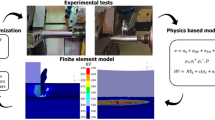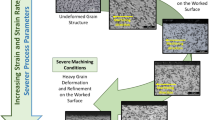Abstract
Numerical solutions based on the finite element technique is widely used over the last decade to develop a realistic model. FEM techniques are sufficiently capable to capture the underlying physics of complex nonlinear problems such as machining. Micro-turning is one such domain of manufacturing process in which material removes at micron range and extensively used in the fabrication of miniature parts such as electronic components, semiconductors, micro-tools. Ti-6Al-4V is widely used material due to its high specific strength and high corrosion resistance. The present work proposes a three-dimensional finite element study based on coupled thermo-mechanical transient analysis of micro-turning process to predict the surface and sub-surface residual stress of Ti-6Al-4V. The strain gradient factor has been coupled with Johnson-Cook flow model to capture the scale effect. Johnson-Cook damage criteria is used to capture the material separation. At low feed, radial and axial residual stresses altered the nature compressive to tensile at a depth 12 μm due to rubbing and ploughing, led to heat generation. Compressive residual stress increases with feed rate because of high strain rate and moreover, the circumferential residual stress (~ 1000 MPa) is found to be much higher than radial and axial. At low feed 3 μm/rev, maximum axial residual stress found at a depth 4 μm from machined surface due to accumulation of dislocation density owing to size effect. The predicted residual stress is validated with Nano-indentation technique and found to be in good agreement. All material properties of Ti-6Al-4V were measured to calculate the residual stress.












Similar content being viewed by others
References
Rack H J and Qazi J I 2006 Titanium alloys for biomedical applications. Mater. Sci. Eng. C 26(8): 1269–1277
Qi D and Ma G 2002 Coal Mining Machinery vol 11, pp 3–4
Nakazawa H 1994 Principles of Precision Engineering. Oxford University Press, New York, Original in Japanese translated by R. Takeguichi
Wada R 1984 Ultra-precision machine and elements therefore. In: Proceedings of 1st IMEC, JMTBA, pp. 36–60
Okushima K and Kakino Y 1972 Study of the residual stress produced by metal cutting. Mem. Fac. Eng. Kyoto. Univ. 34(2): 234–248
Wagner L 1999 Mechanical surface treatments on titanium, aluminium and magnesium alloys. Mater. Sci. Eng. A 263(2): 210–216
Rahman M, Lim H S, Neo K S, Kumar A S, Wong Y S and Li X P 2007 Tool-based nano finishing and micromachining. J. Mater. Process. Technol. 185: 2–16
Masuzawa T 2000 State of the art of micromachining. Ann. CIRP 49: 473–488
Trimmer W S N 1997 Micromechanics and MEMS, Classic and seminal papers to 1990. IEEE, New York
Kussul E, Baidyk T, Ruiz-Huerta L, Caballero-Ruiz A and Velasco G 2006 Scaling down of micro equipment parameters. Precision Eng. 30: 211–222
Joshi S S and Melkote S N 2004 An explanation for the size effect in machining using strain gradient plasticity. ASME J. Manuf. Sci. Eng. 126: 679–684
Lai X, Li H, Li C, Lin Z and Ni J 2008 Modelling and analysis of micro scale milling considering size effect, micro cutter edge radius and minimum chip thickness. Int. J. Mech. Tools Manuf. 48(1): 1–14
Jagadesh T and Samuel G L 2017 Finite element simulations of micro turning of Ti-6Al-4V using PCD and coated carbide tools. J. Inst. Eng. India Ser. C 98(1): 5–15
Wang Z-M, Jia Y-F, Zhang X-C, Fu Y, Zhang C-C and Tu S.-T 2019 Effects of different mechanical surface enhancement techniques on surface integrity and fatigue properties of Ti-6Al-4V: a review. Crit. Rev. Solid State Mater. Sci. 1–25
Abboud E, Attia H, Shi B, Damir A, Thomson V and Mebrahtu Y 2016 Residual stresses and surface integrity of Ti-alloys during finish turning—Guidelines for compressive residual stresses. Proc. CIRP 45: 55–58
Rasti A, Sadeghi M H and Farshi S S 2018 An analytical study on residual 37 stresses in drilling of hardened steel. Int. J. Adv. Manuf. Technol. 99(9–12): 2389–2405
Benjamin B, Andras C, Anna H, Balint K, Antal S, Attila K and Gabor S 2017 Two-dimensional finite element analysis of turning processes. Periodica Polytech. Mech. Eng. 61(1): 44–54
Jeffrey D, Shreyes N, Roberta A and Thomas R 2000 Effect of tool edge geometry on work piece subsurface deformation and through thickness residual stresses for hard turning of AISI 52100 steel. J. Manuf. Process. 2(4)
Meng L, Atli M K, Aqib M S, Yongsheng S, Chenggang F, Hao Z and Ning H 2019 Prediction of residual stresses generated by machining Ti6Al4V alloy based on the combination of the ALE approach and indentation model. J. Braz. Soc. Mech. Sci. Eng. 41(11): 1–15
Eric S, Daniel K, Zanger F, Johannes S and Volker S 2018 Influence of cutting-edge asymmetry on grain refinement of Ti6Al4V. Proc. CIRP 71: 232–237
Liu C and Guo Y 2000 Finite element analysis of the effect of sequential cuts and tool-chip friction on residual stresses in a machined layer. Int. J. Mech. Sci. 42: 1069–1086
Yang X and Liu C 2002 A new stress-based model of friction behaviour in machining and its significant impact on residual stresses computed by finite element method. Int. J. Mech. Sci. 44: 703–723
Sasahara H, Obikawa T and Shirakashi T 2004 Prediction model of surface residual stress within a machined surface by combining two orthogonal plane model. Int. J. Mach. Tools Manuf. 44(7–8): 815–822
Liu C and Mittal S 1998 Optimal pre-stressing the surface of a component by superfinish hard turning for maximum fatigue life in rolling contact. Wear 219: 128–140
Dahlman P, Gunnberg F and Jacobson M 2004 The influence of rake angle, cutting feed and cutting depth on residual stresses in hard turning. J. Mater. Process. Technol. 147: 181–184
Afazov S M, Becker A A and Hyde T H 2010 Effects of micro-stresses from machining and shot-peening processes on fatigue life. Int. J. Adv. Manuf. Technol. 51: 711–722
Suresh S and Giannakopoulos A E 1998 A new method for estimating residual stresses by instrumented sharp indentation. Acta Materialia 46(16): 5755–5767
Oliver W C and Pharr G M 2004 “Measurement of hardness and elastic modulus by instrumented Indentation”: Advances in understanding and refinements to methodology. J. Mater. Res. 19(1): 3–20
Khan M, Hainsworth F M E and Edwards L 2009 Application of the work of indentation approaches for the characterization of aluminium 2024-T351 and Al cladding by nanoindentation. J. Mater. Sci. 44(4): 1006–1015
Chen G, Ren C, Yang X, Jin X and Guo T 2011 Finite element simulation of high-speed machining of titanium alloy (Ti–6Al–4V) based on ductile failure model. Int. J. Adv. Manuf. Technol. 56: 1027–1038
Jomaa W, Mechri O, Lévesque J, Songmene V, Bocher P and Gakwaya A 2017 Finite element simulation and analysis of serrated chip formation during high-speed machining ofAA7075-T651 alloy. J. Manuf. Process. 26: 446–458. https://doi.org/10.1016/j.jmapro.2017.02.015
Liu S 2007 FEM simulation and experiment research of cutting temperature and force in orthogonal cutting of titanium alloys, Dissertation, Nanjing University of Aeronautics and Astronautics, Nanjing
Johnson G R and Cook W H 1985 Fracture characteristics of three metals subjected to various strains, strain rates, temperatures and pressures. Eng. Fract. Mech. 21(1): 31–48
Sun J and Guo Y B 2009 Material flow stress and failure in multiscale machining titanium alloy Ti-6Al-4V. Int. J. Adv. Manuf. Technol. 41(7–8): 651–659
Hascelik A, Aslantas K and Ahmed W 2019. Finite element modelling of edge radius effect in micro turning process. 2019 Advances in science and engineering technology In: International Conferences, ASET 2019, pp. 4–8. https://doi.org/10.1109/ICASET.2019.8714250
Sneddon I N 1965 The relation between load and penetration in the axisymmetric Boussinesq problem for a punch of arbitrary profile. Int. J. Eng. Sci. 3(1): 47–57
Oliver W C and Pharr G M 1992 An improved technique for determining hardness and elastic modulus using load and displacement sensing indentation experiments. J. Mater. Res. 7(6): 1564–1583
Rahul Y K V, Sekhar K and Mathew J 2019 Modeling of mechanical residual stresses in micro-end milling of Ti-6Al-4V alloy. Adv. Micro Nano Manuf. Surf. Eng.. https://doi.org/10.1007/978-981-32-9425-7_36
Rahul Y K V and Mathew J 2021 Methodology for prediction of sub-surface residual stress in micro end milling of Ti-6Al-4V alloy. J. Manuf. Process. 62: 600–612. https://doi.org/10.1016/j.jmapro.2020.12.031
Acknowledgements
The authors express their sincere gratitude to the Department of Science and Technology, Govt. of India for the research facilities under the FIST scheme (SR/FST/ETI 388/2015). The authors also thank Mr Rahul Yadav, Research Scholar, Department of Mechanical Engineering, Indian Institute of Technology Kharagpur, and Dr Jiju V Elias, Asst. Professor, Saingits College of Engineering, for all the support to complete this research.
Author information
Authors and Affiliations
Corresponding author
Rights and permissions
About this article
Cite this article
KHANDAI, D.K., MATHEW, J. & KURIACHEN, B. FEM modelling of residual stresses of Ti-6Al-4V during micro-turning considering the scale effect. Sādhanā 47, 107 (2022). https://doi.org/10.1007/s12046-022-01865-8
Received:
Revised:
Accepted:
Published:
DOI: https://doi.org/10.1007/s12046-022-01865-8




